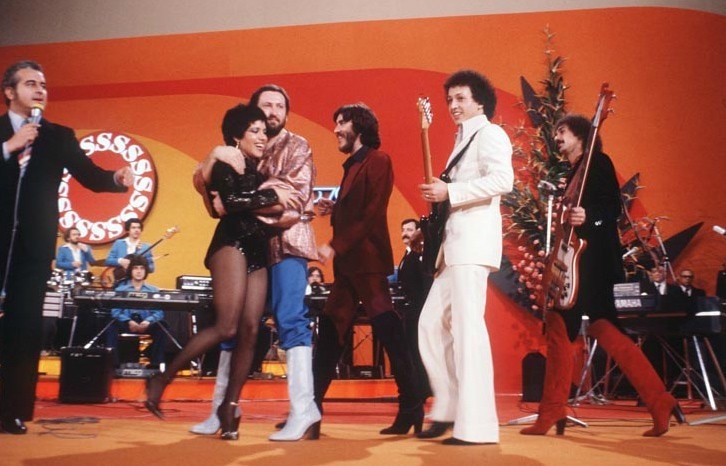Every February, for five days, the eyes of the Belpaese are religiously turned on the seaside town of Sanremo, Liguria, where the annual Festival della Canzone Italiana takes place. For the past seventy years, the music competition that inspired the birth of the Eurovision Song Contest, has been mirroring, in a whirlwind of pundits, furious polemics and flowers, the state of the nation. Sanremo, though, isn’t just about music for music’s sake.
The evolution of stage and costume design have in fact contributed to crystallising the contest’s iconography within Italian culture. From the iconic stairs of the Ariston Theatre stage – which saw names like Dante Ferretti and Emanuela Trixie Zitkowsky designing it, among others – many careers have been launched, as well as dozens of meme-worthy moments of Italian television culture made.
The Fifties, elegance in simplicity
Born in 1951, for that whole decade the festival still owed much of its iconography to the formality of the venue: the Salone delle Feste of the Sanremo Casino. Flowers – for which the Sanremo riviera is known for – and opulent Napolean era-like drapes defined the stage decor for years.
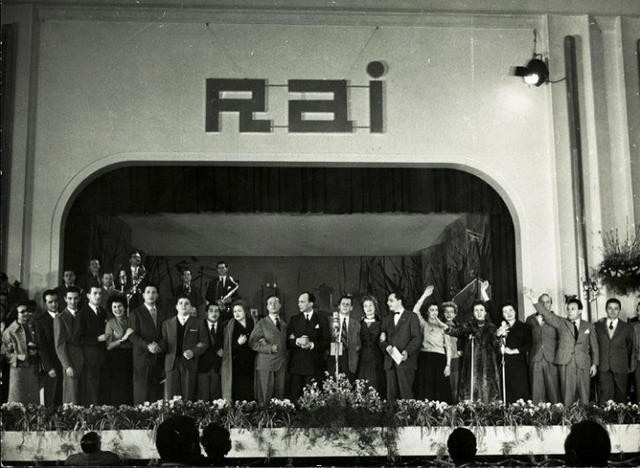
Subtle Art Deco decorations, mostly left to the taste of the Casino’s staff under the creative direction of Lorenzo Musso, completed the set designs. This sober aesthetic mirrored the competing songs, with their well-phrased lines, that still sounded like the sonic heredity of those broadcast by state radio EIAR during the Fascist Ventennio.
After all, in the early days of the contest, the RAI (Italy public service broadcaster) logo on the proscenium was the only trace within the theatre matching the modernist trend that characterised the Italian and European design of the time.
The Sixties, between Space and formality
If Domenico Modugno’s timeless hit Nel Blu Dipinto di Blu (1959) and Gigliola Cinquetti’s Non Ho L’Età (1964) contributed to update the style of the quintessential Sanremo song, it’s not until 1967 that the festival stage finally came to match the direction taken by contemporary design.
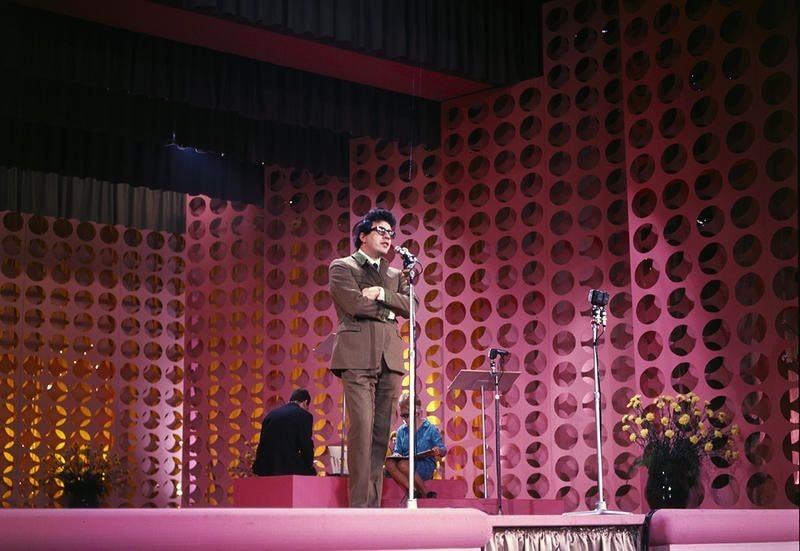
That of 1967 is no doubt a cornerstone edition for Sanremo history. It’s the year singer-songwriter Luigi Tenco is found dead on the floor of his hotel room, a gun next to him, while next door Lucio Dalla can be seen naked, in a state of shock, wrapped up in a fur coat.
Meanwhile, the orchestra, the performers and host Mike Bongiorno move within a stage delimited by a series of perforated pink panels, where multiple cubes resemble those adopted in contemporary yè-yè clubs. Although the female half of the choir still stands a couple of inches below their male colleagues, this set design marks a giant leap for the Sanremo Festival, one towards the fascination for all things Space Age that moves the arts and design in the Sixties.
.jpg.foto.rmedium.jpg)
Oddly enough, the following year, despite the student contestation that set Paris on fire had spread up to Sanremo, the stage decor went back to its morigerated past. Perhaps a symbolic, albeit vain, effort to contrast the Revolution with formal reactionarism.
With great wit, and maybe a pinch of politics, singer-songwriter Sergio Endrigo somehow seemed to capture the clashing spirits of the 1968 edition by thinking, for a minute, to step on stage, sing “the party just begun, has already finished” (the first line of his moving Canzone per Te) and then leave the stage. He didn’t, though, and in the end he was crowned winner.
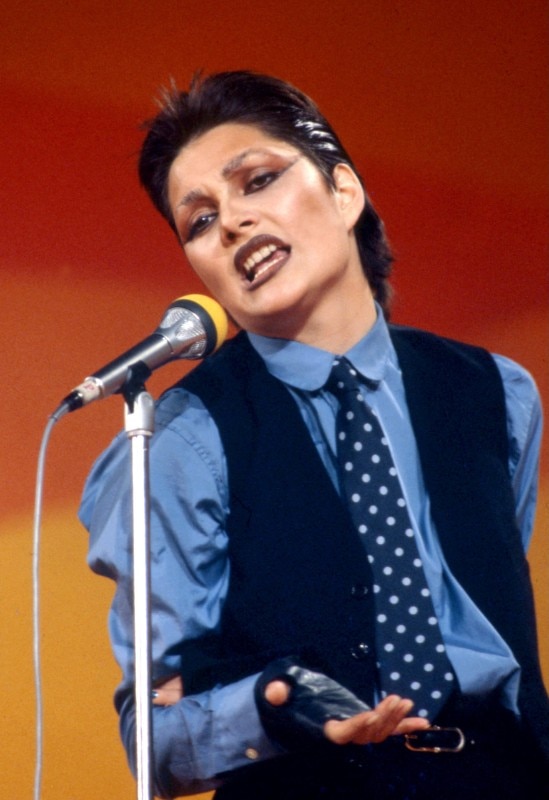
The Seventies, a chromatic explosion
For most of the first half of the Seventies, the Festival di Sanremo kept offering melodic numbers performed by vocal groups and chart-topping singers. Such sonic blandness was mirrored in the timid stage decor, that only dared so much. Art Deco, for instance, defined the typeface used for the sign on the proscenium for the 1976 edition, while Eastern traits characterised the stage in 1973. The visual impact of the stage design for this edition of the festival has only been recently rediscovered, thanks to a tape recorded in Malta where the TV already broadcast colour footage.
It’s not until 1977, when also Italy finally switched to colour television, that the festival’s stages began to keep the pace of the chromatic and design solutions adopted for the interiors of discotheques, homes, and TV shows.
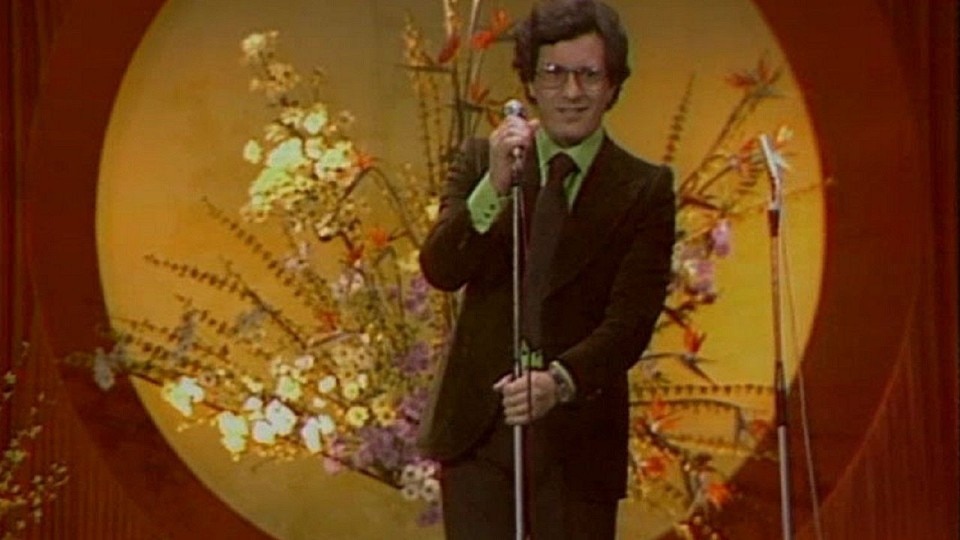
During this time the Sanremo stages began to share similarities with those of the summer music contests seen on TV, like Festivalbar and Saint Vincent Estate. The festival’s logo, at some point, was even reproposed in an irid gradient; as if up until 1977 the RAI flagship TV channel had wanted to impose on the event a morigerated attitude imbibed with Catholic values. A reality that would have come to an end with the escalation of political terrorism and the consequent advent of the opulent Yuppy era of the so-called Milano da Bere.
Rino Gaetano captured this end-of-an-era feeling by ironically performing in a tail-coat at Sanremo 1978, against a backdrop made of sinuous patterns in a red and orange gradient. A stage design that hooked the audience from home, introducing them to punk when Anna Oxa appeared wearing a slicked back mullet, a loud garçon outfit and Vivienne Westwood-like make-up, which captured the public opinion as much as her hit song Un’Emozione da Poco. A chromatic exploit, the 1978 edition also saw winners Matia Bazar wearing Rocky Horror Picture Show-meet-Spiders from Mars-like glam outfits.
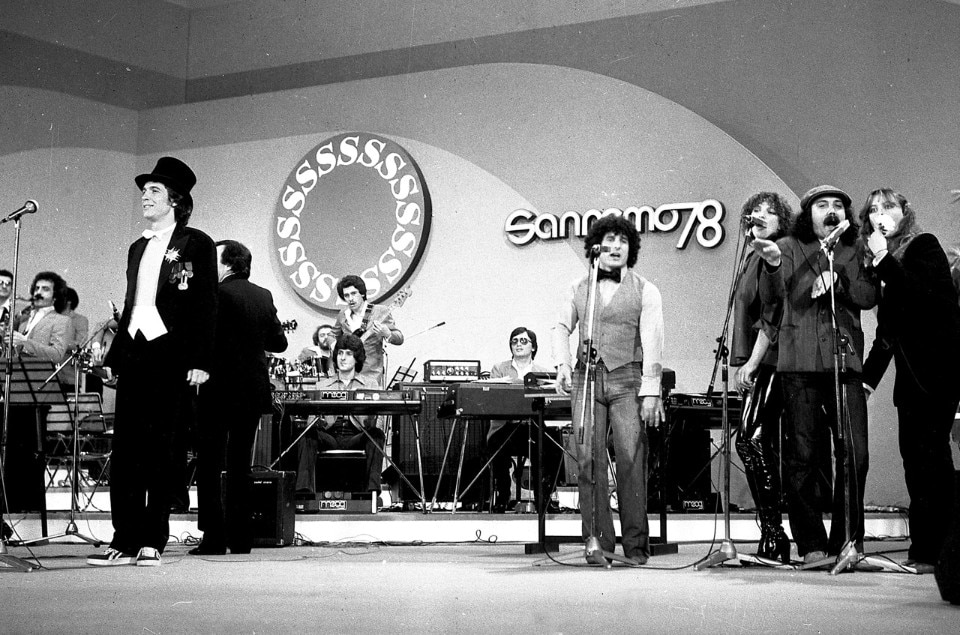
The Eighties, the disco as an inspiration
In the 1980s a new course in Sanremo stage design began. With Enzo Somigli the 1981 and 1982 editions of the festival set the standard for the style to come both inside and outside the Ariston Theatre. Backlit glass surfaces and a taste for postmodern architecture defined the stage decor, matching the set up for the Italian Socialist Party (PSI) congresses of the 1980s, like the one designed by Filippo Panseca for the 1989 Milan rally.
Squared smoked glass surfaces defined the 1983 edition, becoming the stage for Peter Gabriel’s raucous performance. Gabriel, a foreign guest on the night, with his face painted like a monkey’s, dangerously swung over the rather perplexed audience with the aid of a rope, while Shock The Monkey played in playback. This was just one of several performances where foreign guests simply took the piss of the buttoned up atmosphere of the contest. In 1981 Bad Manners’ frontman Buster Bloodvessel undressed to his pants on stage, while in 1996 Blur displayed a 2D cardboard silhouette of their guitarist Graham Coxon, as a tongue-in-cheek reference to the imposition of lip-syncing their single Charmless Man.
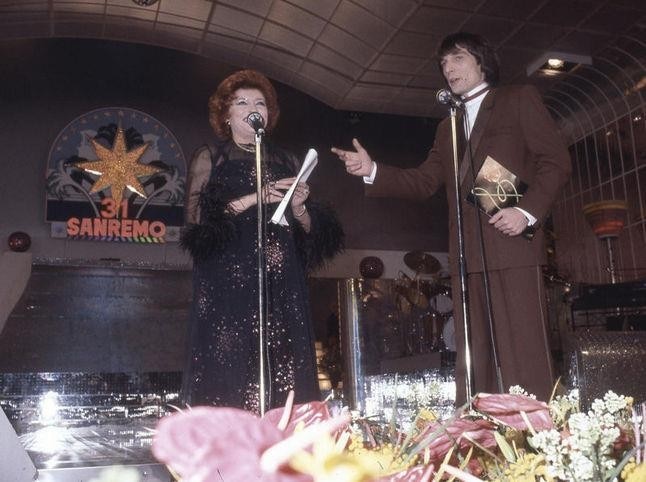
After all, during the 1980s the idea of using the Sanremo stage as an opportunity for broader artistic performances going beyond music for music’s sake began to take place. The Ribelli had already set a precedent in 1966, when they wore wigs as a satirical comment on the stir caused by The Beatles in the Italian public opinion. However, it was Loredana Bertè’s performance in 1986 to truly shock and divide the audience. The singer stepped on stage with a fake pregnant belly wrapped in a latex bodysuit, as a provocation on the role of the woman within Italian society. The prompt ended up eclipsing her song, and – according to Bertè herself – only Sting seemed to appreciate her performance idea on the night.
It was perhaps in 1985, though, that Sanremo reached its dystopian and retro-futuristic design peak, with a stage designed by Luigi Dell’Aglio that seemed to incarnate all the influences coming from the iconography of The Rockets, Giorgio Moroder and Blade Runner. Artists stepped on the staircase leading to the stage out of a dark corridor where neon lights delineated a bright blue reticulate. Winning band Ricchi & Poveri matched such a vibe with their female singer, Anela ‘Brunetta’ Brambati, performing in a silver Domopak-like coord.
From the Nineties to present days, the festival as a television gala
Following the exploit of strobe lights during the Eighties, the Nineties marked a return, although cheesy, to a neoclassical and Liberty-nodding style, made of trompe l’oeil surfaces, statues and candid palettes shared by TV variety shows and Las Vegas casinos.
However, by the end of the decade started to emerge the elements that still characterise the Sanremo stage to these days: imponent led walls, a dominance of blue lights and a setup that, year after year, has increasingly turned a strictly-musical competition into a pompous TV show, following the path marked by the Eurovision. Among these stages, it’s worth mentioning the one designed by Oscar-winner Dante Ferretti for the 2006 edition, defined by charming Fellinesque and classic Hollywood reminiscences.
.jpg.foto.rmedium.jpg)
During the last decade, fashion rose at Sanremo, where a renewed interest in the role of stylist and designers emerged following the appeal generated by events like the MET Gala. As the classic black tie and tuxedo combo that characterised the traditional male Sanremese outfit became rarer and rarer to spot on stage, artists developed an increasingly conscious and playful attitude towards their clothes. A trend that Patty Pravo, decadent queen of Italian pop, had somehow started as early as 1984 when she descended the Ariston staircase wearing a total look by Versace, paving the way for the prominence of Gucci and its recent creations for the likes of Maneskin and Achille Lauro
After all, the city and its Casino had been hosting, since 1952, the Italian Male Fashion Festival, one of the most prominent events in the Belpaese for the post-war ready-to-wear textile industry as recently thoroughly documented by fashion researcher Marta Franceschini.
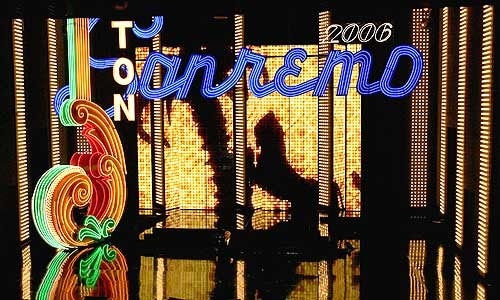
At this point we should therefore ask ourselves whether Sanremo and its stages have always succeeded in faithfully interpreting the spirit of the times, both inside and outside of the Ariston Theatre. With the succession of different artistic directors, stage and costume designers, the festival intercepted it on some occasions, just like it failed to do so on others. It’s not just hard, but also without any use trying to come up with a Sanremo theory, or an algorithm of sorts. It is, in fact, this unpredictability what truly fascinates the audience about Sanremo, what draws them to keep their eyes peeled in front of their TV screens for five days, singing songs, making predictions and arguing.
Once in the cafes, now on social media. Another sign of the evolving times, but also a spring that through retromania, the appeal for designer costumes, and an ironical approach to trash television has sparked, after decades, a renewed interest in the festival from the younger generations of Italians. It’s only pop music, but we like it.
Opening image: Matia Bazar, winners of the Festival di Sanremo 1978, in their Glam costumes. Photo Archivio Ragazzi di Strada


